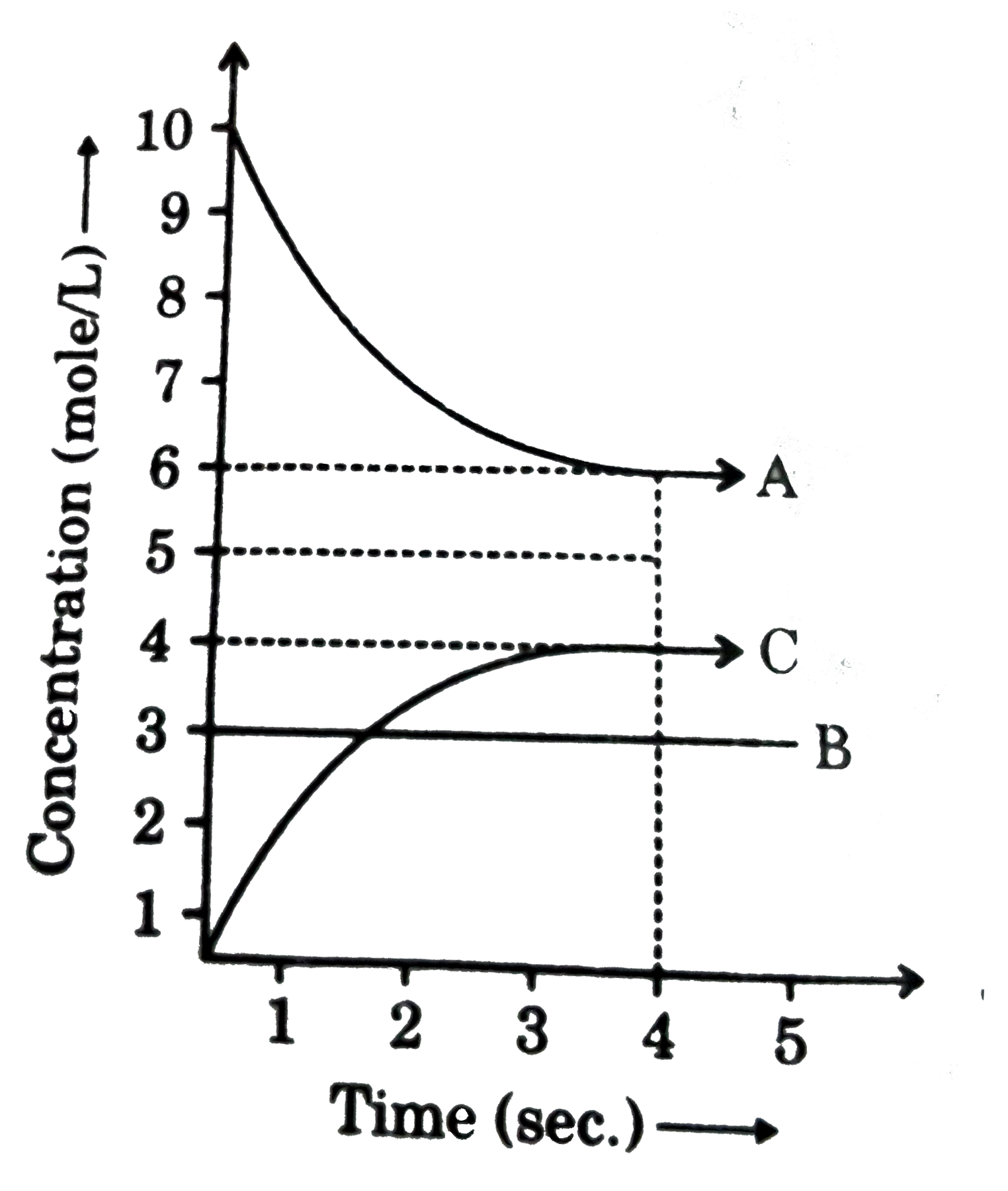X, Y and Z react in the 1:1:1 stoichiometric ratio.
The concentration of X, Y and Z we are found to vary with time as shown in the figure below:

The value of the equilibrium constant (Kc) for the equilibrium represented the in above sketch will be
92
114
23
107
The correct Answer is:C
X(g)+Y(s)⇐⇒Z(g)From grapht=tEq66(concentrated)
∴Kc=[Z][X]=46=23
Topper's Solved these Questions
- CHEMICAL EQUILIBRIUMBook:CENGAGE CHEMISTRYChapter:CHEMICAL EQUILIBRIUMExercise:Exercises (Multiple Correct)
Explore 26 Videos
- CHEMICAL EQUILIBRIUMBook:CENGAGE CHEMISTRYChapter:CHEMICAL EQUILIBRIUMExercise:Exercises (Single Correct)
Explore 58 Videos
- CHEMICAL EQUILIBRIUMBook:CENGAGE CHEMISTRYChapter:CHEMICAL EQUILIBRIUMExercise:Exercises (Subjective)
Explore 46 Videos
- CHEMICAL BONDING AND MOLECULAR STRUCTUREBook:CENGAGE CHEMISTRYChapter:CHEMICAL BONDING AND MOLECULAR STRUCTUREExercise:Archives Subjective
Explore 15 Videos
- CLASSIFICATION AND NOMENCLATURE OF ORGANIC COMPOUNDSBook:CENGAGE CHEMISTRYChapter:CLASSIFICATION AND NOMENCLATURE OF ORGANIC COMPOUNDSExercise:Analytical and Descriptive Type
Explore 3 Videos
Similar Questions
In a chemical reaction , A+2BK⇐⇒2c+D, the initial concentration of B was 1.5 times of the concentrations of A , but the equilibrium concentrations of A and B were found to be equal . The equilibrium constant (K) for the aforesaid chemical reaction is :
View SolutionThe equilibrium concentration of x, y and z are 4,2 and 2 mol L−1, respectively, at equilibrium of the reaction 2x+y⇔z. The value of Kc is ……………..
View Solution
Knowledge Check
A,B and C react in the 1:1:1 stoichiometric ratio. The concentration of A,B and C where found to vary with time as shown in the figure below:

The value of equilibrium repreasented in above sketch will be :A127B23C2D29X, Y and Z react in the 1:1:1 stoichiometric ratio.
The concentration of X, Y and Z we are found to vary with time as shown in the figure below:

Which of the following equilibrium reaction represents the correct variation of concentration with time?AX(g)+Y(g)⇔Z(g)BX(g)+Y(s)⇔Z(g)CZ(g)+Y(g)⇔X(g)DZ(g)+X(g)⇔Y(g)X, Y and Z react in the 1:1:1 stoichiometric ratio.
The concentration of X, Y and Z we are found to vary with time as shown in the figure below:

If the above equilibrium is established in a 2.0L container by taking reactants in sufficient amount then how many moles of components Y must have reacted to establish the equilibrium?A0B6C12D8
A,B and C react in the 1:1:1 stoichiometric ratio. The concentration of A,B and C where found to vary with time as shown in the figure below:

Which of the following equilibrium reaction represents the correct variation of concentration with time?
View Solution5 mole of X are mixed with 3 moles of Y. At equilibrium for the reaction, X+Y→Z 2 moles of Z are formed. The equilibrium constant for the reaction will be
View SolutionFive hypothetical gases having name A,B,X,Y and Z are having boiling point in the range of 4.9 K to 6.9 K. Gases A and B are reacting to produce gases X,Y and Z as per the following stoichiometric equation in a container of volume 0.9 L pressure 1 atmosphere and at temperature 8.513K ( at equilibrium ) .
A(g)+B(g)→X(g)+Y(g)+2Z(g)
At the condition of equilibrium, which of the following statement is correct ?
View SolutionΔG∘ for the reaction X+Y⇔Z is -4.606 kcal. The value of equilibrium constant of the reaction at 227∘C is (R = 2 Cal/mol K)
View SolutionIn the reaction X(g)+Y(g)⇔2Z(g),2 mole of X,1 mole of Y and 1 mole of Z are placed in a 10 litre vessel and allowed to reach equilibrium .If final concentration of Z is 0.2 M , then Kcfor the given reaction is :
View Solution

